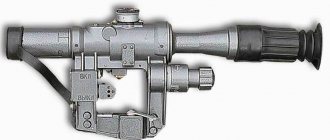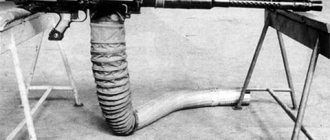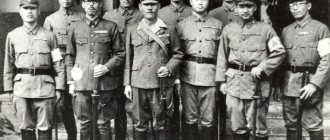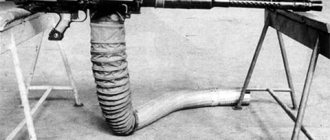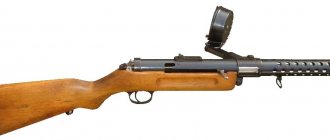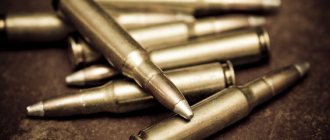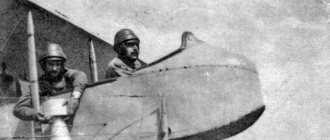During war, technologies are always developed that are not in demand in peacetime. The armament of troops is constantly being improved, which, in turn, leads to the fact that inventors are constantly working to improve weapons for military forces.
The invention of the machine gun and its appearance on the battlefield dramatically changed the situation during combat operations.
From their first appearance to the present day, Russian machine guns have gone through a long evolution. At the beginning of their journey on the battlefields, machine guns had a narrow specialization. Now it is difficult to imagine a combat operation without the use of machine guns.
Manual Kalashnikov
It was possible to equip troops with light machine guns of the AKM modification in 1961, when the RPK went into production.
Russian submachine guns, to which the RPK belongs, are designed to strengthen motorized rifle units with firepower to destroy not only firing points, but also enemy personnel.
With the use of broad unification of components and parts of the RPK with the AKM mastered by the troops, it was possible not only to widely introduce it into the troops, but also to significantly simplify its production.
The basic design of the AKM simplified the handling of weapons due to ease of disassembly, maintenance and maintainability.
Russian submachine guns such as the RPK also had a downside. Unlike the AKM assault rifle, the requirements for the survivability of parts were increased. The RPK was produced at the machine-building plant.
The RPK was produced in various modifications, for example:
- RPKN (active-type night sight NASP-2), target detection range - 150–250 m;
- RPKL (night non-illuminated sight of the intensifying type NSP-3) range 250–300 m;
- RPKN-1 (NSPU non-illuminated night sight), range – 300–700 m;
- RPKN-2 (lightless night sight upgraded PSPUM);
- RPKN-2. It was equipped with an NSPU-3 sight with a dovetail mount. This made it possible to detect a target in the light of the stars or the moon at a distance of up to 600 meters.
When developing the supply of cartridges for a machine gun, more capacious magazines were made. They are box-shaped - sector-shaped. The arrangement of cartridges in the magazine is two-row for 40 rounds. And 75 rounds in drum form.
In a drum magazine, as in a box magazine, cartridges are fed using a feeder with a spring. Unification is achieved by the fact that the magazines are interchangeable with automatic ones.
It is possible to fire a machine gun while standing, resting on the shoulder, from the knee, or lying down with a bipod.
The PKK is in service in more than 20 countries. In addition, in some countries, independent copies are produced.
Russian machine guns
Light machine guns
Light machine guns, superior in combat capabilities to assault rifles and machine guns, are designed to destroy manpower at distances where the latter’s fire is ineffective - up to 1000 meters.
Light machine guns usually have the same caliber as the machine gun in service, differing in a heavier barrel, larger magazine capacity or the possibility of belt feeding, and firing supported by a bipod. This provides better accuracy and a higher combat rate of fire - up to 150 rounds per minute in bursts. The weight of light machine guns when fully loaded is usually 6 - 14 kg, and the length is close to the length of rifles. This allows machine gunners to operate directly in the combat formations of units. Modern light machine guns fill the gap between individual and group weapons. The main method of firing a light machine gun is with a bipod resting on it and the butt resting on the shoulder, but it is also necessary to be able to fire from the hip while moving. The main problem of a light machine gun is the need to combine small size and weight with a higher intensity of fire, accuracy and supply of ammunition than a machine gun. This problem has several solutions. Simple and cheap is to equip an assault rifle or assault rifle with a bipod and a slightly more capacious magazine (Israeli machine gun "Galil" ARM, German MG.36). The second option involves creating a light machine gun based on an assault rifle with the installation of a heavier barrel and changing the controls, as was done in the Soviet RPK and RPK 74 or the British L86A1 (L86A1). In this case, in the platoon section, the weapons are unified in terms of cartridge and system. Finally, it is also possible to develop an independent design. An example of this approach is the Belgian Minimi machine gun and the Singaporean Ultimax 100.
Easel and single machine guns
Easel and single machine guns make it possible to hit various fire weapons and enemy personnel located openly and behind light shelters at a distance of up to 1500 m. The recoil of the weapon when firing is perceived by the installation (machine), as a result, the stability and controllability of the machine gun increases. Stability, a massive replaceable barrel and a significant cartridge belt capacity provide the ability to conduct targeted fire in long bursts. The combat rate of fire reaches 250-300 rounds per minute.
The design of the machine makes it possible to quickly and accurately transfer fire from one target to another, fire with predetermined settings, and also hit air targets. It is clear that such weapons are heavier than light machine guns: the weight of a machine gun on a tripod machine is 10-20 kg, with a wheeled machine gun (remaining on some outdated models) - 40 kg or more. A heavy machine gun is usually serviced by two crew numbers. Changing positions takes two to three times longer than with a light machine gun.
The so-called “single” machine guns, so named for qualities that combine the properties of light and heavy machine guns, turned out to be more promising. Single machine guns retain the firing capabilities of easel ones, but maneuverability is significantly increased due to light tripod machines (the weight of a single machine gun with the machine gun is 12-25 kg) and the ability to fire from a bipod (the weight of a machine gun on a bipod is 7-9 kg). Fire from a bipod is carried out at a range of up to 800 m. Single machine guns have wide capabilities to destroy enemy fire weapons and manpower, low-flying and hovering air targets.
Since the power of low-pulse machine gun cartridges does not allow effective fire beyond 600 m, single machine guns chambered for rifle cartridges continue to hold a strong position in the infantry weapons system. The “uniform” nature of machine guns is also reflected in their installation (with some modifications) on tanks, armored vehicles, and airborne transport helicopters. The best single machine guns include the Soviet PKM and the Belgian MAG.
Attempts are being made to develop single machine guns for low-pulse small-caliber cartridges (for example, the Spanish “Amelie” or the Israeli “Negev”). Such machine guns already fall into the “weight category” of manual ones. They, in particular, found application as light group weapons in airborne and reconnaissance sabotage units. In some armies, single machine guns are used instead of light machine guns. A number of experts say that in the near future it is possible that the light machine gun will “fall out” of the weapon system due to an increase in the accuracy of fire of machine guns, on the one hand, and the lighter weight of single machine guns, on the other. But for now, light machine guns retain their importance and their positions. Of the various schemes of field machines, the obvious victory was won by light tripod machines with variable height of the line of fire and horizontal and vertical guidance mechanisms, and the requirement for anti-aircraft shooting is not considered mandatory - in a number of armies, special installations are preferred for firing machine guns at air targets.
Modern sights - optical, collimator, night, and combined - significantly expand the capabilities of machine guns. Optical and red dot sights are becoming increasingly common on machine guns.
Reducing the mass of single machine guns, as well as increasing their accuracy when firing from a bipod, remains an important area for their improvement. It must be remembered that the crew, in addition to the machine gun and ammunition, has to carry an automatic grenade launcher system, hand and rocket-propelled grenades.
Heavy machine guns
Large-caliber machine guns are designed to hit airborne and lightly armored ground targets. The 12.7-15 mm caliber allows you to have a powerful cartridge with armor-piercing, armor-piercing incendiary and other bullets in the ammunition load. This ensures the destruction of ground targets with an armor thickness of 15-20 mm at ranges of up to 800 m, and fire weapons, manpower and air targets - up to 2000 m. The combat rate of fire of heavy machine guns when firing at ground targets is up to 100 rounds per minute in bursts.
Large-caliber machine guns significantly complement the fire system in all types of combat. Anti-aircraft heavy machine guns have found widespread use as a means of air defense for units. For the same purposes, such machine guns are installed on tanks, armored personnel carriers, and infantry fighting vehicles. Thus, heavy machine guns are the most powerful type of small arms for hitting ground and air targets, but also the least mobile. Nevertheless, interest in them does not decrease. This is due to the firing range of heavy machine guns, which allows them to fight important targets (snipers, machine gunners in cover, fire crews) and air attack weapons.
The most common in the world are two old models of 12.7 mm machine guns - the Soviet DShKM and the American M2HB (M2HB) "Browning" (chambered with a less powerful cartridge). The mobility of heavy machine guns is limited by their significant mass and size. Machine guns are placed on universal or special (ground or anti-aircraft) field machines. With a universal machine gun, the weight of machine guns can be 140-160 kg, with a light ground machine - 40-55 kg. But the emergence of significantly lighter heavy machine guns - the Russian NSV 12.7 and KORD, the Singaporean CIS MG50 (CIS MG50) - brought their mobility and camouflage capabilities closer to single machine guns on the machine. It is worth noting that other attempts have been made for several years to replace large-caliber machine guns with light automatic cannons of 20-30 mm caliber. However, the development of sufficiently light (taking into account the weight of the weapon itself, installation and ammunition) and mobile samples poses serious difficulties. So far, such guns have found application as weapons for light army vehicles and light helicopters.
Kalashnikov PKTM tank machine gun
The Kalashnikov tank machine gun (PKTM) of 7.62 mm caliber has become a successful model as a new Russian machine gun for manning tanks. It was also equipped with armored vehicles, helicopters, armored boats and other equipment both to engage manpower with dense fire and to suppress enemy firing points. Shooting is carried out using metal tape of various capacities:
- 100;
- 200;
- 250 rounds (regular, armor-piercing incendiary, tracer bullets and bullets with increased penetration).
US machine guns
John Browning began developing a large-caliber machine gun to combat armored vehicles and aircraft in the last years of the First World War. In the early 20s, it began to enter the troops under the designation M1921. This model, with a water-cooled barrel, was produced until 1933.
That year, two variants were released simultaneously, under the same designation M2 - with an improved water cooling system, and a sample whose barrel was cooled by air. The air-cooled version turned out to be so successful that it is still in production.
In the early 40s, Melvin Johnson proactively developed a self-loading rifle of .30-06 caliber and its automatic version, suitable for use as a light machine gun. Before World War II, the United States did not accept them for service, and the weapons were not sent to the Dutch East Indies before the Japanese invasion.
As a result, the Johnsons were used to a limited extent by sabotage and reconnaissance detachments, since they were lighter than standard Browning automatic rifles.
The first attempt by the United States to create a single machine gun can hardly be called successful. American Saco M60 arr. 1957 proved to be unreliable and capricious, and its sight, bipod and gas outlet were attached to a replaceable barrel. However, it was produced unchanged until the early 80s.
In the 80s, as part of the modernization, the M60 received a new bipod, a modified barrel mount and a different gas outlet.
At the same time, reliability not only did not increase, but, it is believed, even fell. The shortcomings were finally overcome only in the M60E4 model, but by this time the United States had already adopted the Belgian model - FN MAG.
The designer of the M16 rifle, Eugene Stoner, developed the Stoner 63 modular rifle system in 5.56 mm caliber in the 60s. It also included a tape-fed sample. The system, which turned out to be quite capricious and demanding to maintain, was not accepted for service, but as part of military testing, Stoner’s weapons were actively used by US Navy special forces in Vietnam. These machine gunners were even given the nickname “Stonermen”.
In parallel with the Stoner system, light support weapons based on the AR-15 platform were being developed. The Colt CMG-2 version was offered for testing to special forces fighting in Vietnam, but to no avail. After this, development stopped.
Since the 80s, the Belgian Minimi (under the symbol M249) has become the main support weapon for the US armed forces branch. However, by the beginning of the 2000s, the power of the 5.56 mm cartridge no longer satisfied everyone - for example, special forces considered it insufficient. Existing 7.62 mm caliber samples were considered too heavy. As a result, the Mk.48 appeared - a variant of the M249 chambered for a 7.62x51 caliber rifle cartridge.
In the 2000s, the Americans began to develop a new light machine gun, which would be inferior in weight to the M249.
During the LSAT project, two variants of weapons were studied - with caseless cartridges and with ammunition in which the bullet is recessed in a plastic sleeve. It was expected that if successful, LSAT could be put into service as early as 2016. This did not happen - in 2018, a new program for the development of promising automatic weapons was launched.
Machine gun "Pecheneg"
"Pecheneg" is a new Russian machine gun, similar to the PKM. The main difference from the basic one is the barrel design and the presence of a casing. This improved cooling, protected from atmospheric fluctuations, protected the sight line from thermal effects and increased the rigidity of the entire structure. The production of an improved machine gun was established at a mechanical plant in the city of Kovrov.
Upgraded Kalashnikov PKM machine gun
PKM is another model that represents Russian machine guns, measuring 7.62 mm. The use of a bipod on a machine gun made it possible to improve the accuracy of fire with both conventional cartridges and their various modifications.
Ammunition is provided by belts of 100 and 200 rounds of ammunition, placed in portable boxes. The automation with which these Russian machine guns are equipped operates due to the force of powder gases discharged from the barrel, and is equipped with a gas regulator in three positions depending on the normal or difficult type of operation of the weapon.
Specifications
Here are some parameters of modern infantry support weapons.
Light machine guns
| RPK-16 | Mk.48 | MG4 | |
| Weight, kg | 4,6 | 8b2 | 8,1 |
| Barrel length, mm | 415 | 502 | 482 |
| Rate of fire, rounds per minute | 700 | 710 | 880 |
Single machine guns
| Pecheneg | M60E4 | MG3 | |
| Weight, kg | 8,2 | 10,5 | 10,5 |
| Barrel length, mm | 658 | 560 | 565 |
| Rate of fire, rounds per minute | 650 | 550 | 1200 |
Heavy machine guns
| M2HB | CORD | |
| Weight, kg | 58 | 41 |
| Barrel length, mm | 1143 | 1070 |
| Rate of fire, rounds per minute | 635 | 750 |
It is noticeable that most of the given samples are close in characteristics. The RPK-16, which is closer to machine guns than to weapons like the M249 - with a replaceable barrel and belt feed, stands out strongly due to its low mass.
Even the most modern of the examples presented usually represent a development of well-known and proven design ideas.
Even the Pecheneg cooling system was not developed from scratch - the Lewis had a similar device during the First World War.
The American experimental LSAT, using fundamentally new ammunition, remained a prototype, which means that the main innovations are yet to come.
Upgraded Kalashnikov machine gun on the Stepanov PKMS machine gun
For PKM in 1969, a 6T5 tripod type machine (designed by Stepanov) was developed and adopted. The main requirement for the development of this machine is the use of a machine gun for anti-aircraft shooting. In this case, the frame of the vertical guidance device is used as a stand, where the base bushing is used to attach the hind legs.
When mounting the cartridge box on the right rear “tripod” of the machine, you can change the firing position without unloading. This machine is applicable to a single weapon, which includes modern Russian machine guns, which does not impair the accuracy of fire, which, in turn, made it possible to reduce the total weight of the machine gun compared to Samozhenkov’s machine gun.
Smart hydrophones
It is known that various remote-controlled robotic systems are already being used to protect particularly important military installations. They can function both autonomously and under the control of an operator, Vadim Kozyulin told Izvestia.
“Such complexes provide visual surveillance of the controlled territory, are equipped with loudspeakers, cameras, a thermal imager and other technical means of detecting intruders,” the expert listed. “When an intruder appears, such systems warn via loudspeaker that he should not be in the protected area and offer to stay in location before the patrol arrives. If the warning is ignored, at the command to “open fire,” the cap opens and a combat module with grenade launchers and a machine gun moves up.
Now the army and navy are actively introducing new types of equipment that provide reliable protection of military facilities. As Izvestia wrote, the DIABAS hydroacoustic anti-sabotage system entered service with the Navy. It allows you to detect saboteur swimmers. The complex consists of hydrophones and a standard container, where workplaces are equipped for operators monitoring the situation. Hydrophones installed at the bottom or on piers can easily find not only swimmers, but also underwater drones. The system is as mobile as possible. The container can be loaded onto a truck and transported to the desired location.
Also, the anti-sabotage forces of the Navy are receiving Tachyon aerial drones. Their equipment allows them to detect enemy swimmers at a depth of several meters.
Machine gun "Kord"
The Kord heavy machine gun was created after the collapse of the USSR, when Russian light machine guns had to be assembled at new sites. Designers of the Kovrov plant named after. Degtyarev, work was carried out to create a new type of machine gun.
For the new machine gun, the designers initially designed the possibility of double-sided loading of the machine gun (both on the left and on the right). The sight is equipped with 100 m notches for a range from 400 to 2000 meters. It is also possible to install optical, collimator and night sights on the machine gun. The machine gun is equipped with a 6T7 folding ground mount.
Image library
Externally, the new Russian security robot resembles an armored turret from a combat vehicle. In the event of an alarm, the installation is brought into combat position. The installation received standard optical-electronic systems, as well as radars that make it possible to detect targets not only in daylight, but also at night. It is made using technologies that are used to create neural networks. A special algorithm allows artificial intelligence to determine who is in the forbidden zone - a person or, for example, an animal.
“Such algorithms work quite simply,” Vadim Kozyulin explained to Izvestia. — The installation finds the target, checks it against the image library and, if the object is included in it, warns the operator of the danger.
At the same time, electronics can understand how dangerous a person is to an object by comparing his behavior with examples embedded in the matrix. For example, it identifies military small arms in the hands of the enemy and distinguishes them from hunting ones.
The algorithm also contains certain signs of terrorist activity in human behavior. Their presence will allow the electronics to warn the operator of the danger. Based on the characteristics of the target or terrain, a decision will be made about when and in what mode it is better to hit the target.
The new installation will be able to open fire only at the command of a serviceman. He will be able to monitor the situation remotely - from a special shelter or command post. Optical-electronic systems and radars will not only provide targeting, but also monitor the destruction of targets.
The operator will be able to independently control the security robot. To do this, he has a remote control and control panel, on which he receives a picture from the tracking tools included in the standard set of equipment of the installation. Signal exchange between the unit and the control panel is via a secure network.
“Dagger” in sheath: infrastructure is being prepared for hypersonic missiles
Arsenals and special sites for testing and servicing ammunition are being deployed in Russian regions
NSV-12.7 "Utes", large-caliber
At the end of the 60s, Russia needed to update its weapons. Machine guns, especially large-caliber ones, have undergone deep modernization. Experimental design work under the code "Utes" is intended to replace the DShKM.
The new machine gun received a replaceable barrel, which is secured in the receiver using a locking wedge. After firing 100 shots, the barrel is replaced (or cooled). Using the handle on the barrel, it is replaced, as well as the machine gun is carried.
Vladimirov machine gun - KPV
Specialists from different countries carried out experimental work to increase firepower on various modifications - both single-barrel and multi-barrel ones were improved. Russian machine guns of the Vladimirov system are the most powerful of all mass-produced heavy machine guns.
The machine gun had a caliber of 14.5 mm and was adopted as an infantry one. It was equipped with a field machine of the Kharykin system.
Machine gun modifications:
- anti-aircraft, quad ZPU-4 (designed by Leshchinsky);
- twin ZPU-2 (Vladimirova and Markov);
- mountain ZGU-1;
- airborne ZU-2.
When used as an anti-aircraft gun, the machine gun was fired in short bursts of 5 shots or long bursts of 20 shots. During continuous shooting, fire is possible in bursts of up to 150 shots (after this the barrel will need to be replaced). The tank version of the KPVT was used on heavy tanks (as anti-aircraft tanks, in a twin version). This installation could also be found on armored personnel carriers and combat reconnaissance and patrol vehicles.
Lead the process
As sources in the military department told Izvestia, when guarding particularly important military installations, new stationary armored installations armed with machine guns will be used. Now the development is already at a high level of readiness, they plan to send it for testing in the near future. After being put into service, the new installation will be included as one of the combat elements in the future complex for the protection of military facilities, the sources noted.
Now all the armies of developed countries are trying to achieve maximum automation of weapons systems and it is almost impossible to stop this process - it needs to be led. Moreover, we are not falling behind, military expert Vadim Kozyulin assured Izvestia.
“Automated rifle installations are already in service with other countries,” he explained. “For example, in South Korea, similar systems armed with a machine gun are used to protect the border. They are equipped with loud-speaking devices that can be used to warn the offender that he is committing illegal actions. It is believed that they can only open fire with the operator's permission, but it is possible that the human control function can be disabled. Tests show that such shooting systems, as a rule, cope with the task better than a person - they find targets faster and hit them more accurately. In addition, studies show that a soldier only correctly identifies the target 80% of the time. In the future, such installations can be made mobile or placed on flying drones.
“Thor” is appropriate: the south of Russia was covered with anti-aircraft robotic guns
In many characteristics, the air defense system is superior to its Western counterparts
